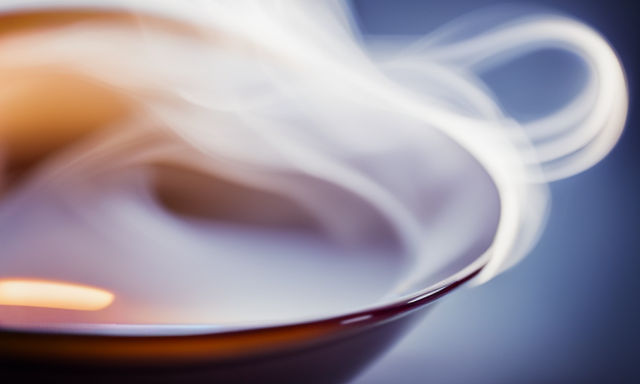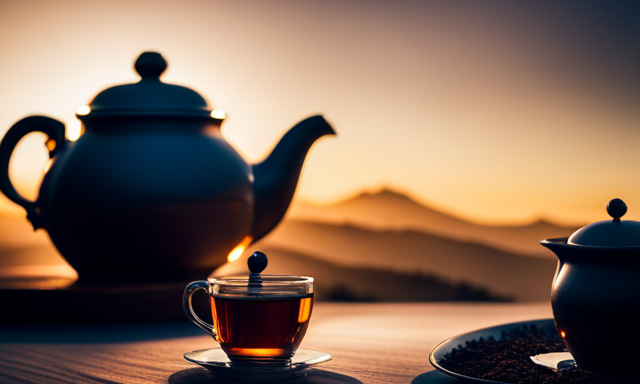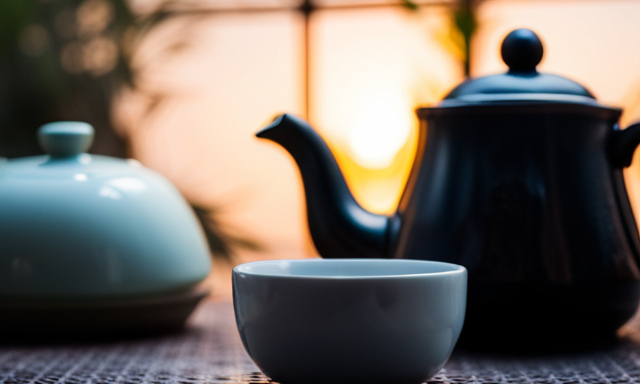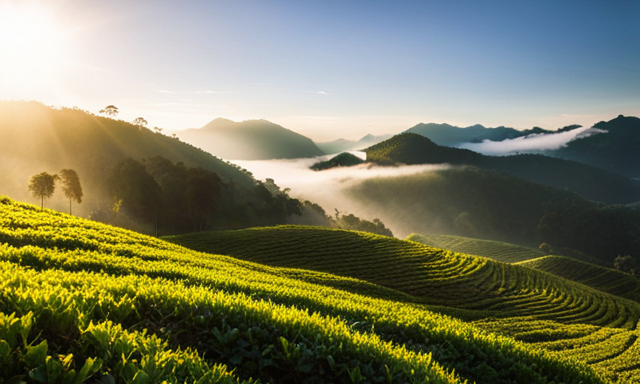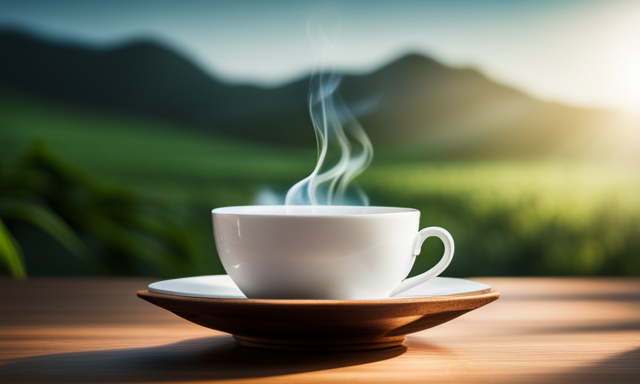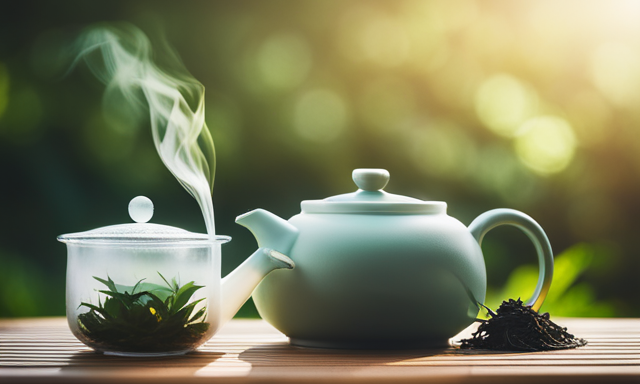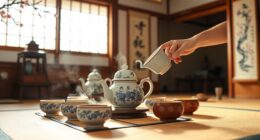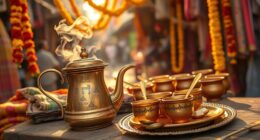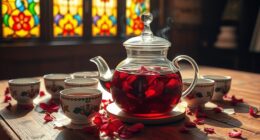What type of tea is oolong tea?
Oolong tea is a type of tea that falls somewhere between green tea and black tea in terms of oxidation. It is often referred to as a semi-oxidized tea. The oxidation process for oolong tea can range from 10% to 80%, depending on the desired flavor and characteristics.
Oolong tea originated in China and has a long history dating back hundreds of years. It is traditionally grown and produced in regions such as Fujian and Guangdong, but it is now also produced in other countries like Taiwan and Thailand.
The production process for oolong tea is quite intricate and involves several steps. After the leaves are harvested, they are withered under the sun or in a controlled environment. This helps to remove excess moisture from the leaves. The withered leaves are then bruised or rolled to initiate the oxidation process. The oxidation is then halted at the desired level by heating or steaming the leaves. Finally, the leaves are dried and sorted.
The flavor profile of oolong tea can vary greatly depending on factors such as the oxidation level, the terroir, and the specific cultivar used. Oolong teas can range from floral and fruity to woody and roasted. Some oolong teas have a smooth and creamy texture, while others have a more brisk and astringent quality.
In terms of cultural significance, oolong tea holds a special place in Chinese tea culture. It is often served during formal tea ceremonies and is highly regarded for its complex flavors and aromas. Oolong tea is also enjoyed in other Asian countries like Taiwan and Japan, where it is appreciated for its unique characteristics.
So, whether you’re looking to explore new flavors or deepen your appreciation for tea, oolong tea is definitely worth trying. Its delicate flavors, rich history, and cultural significance make it a true gem in the world of tea. So go ahead, brew yourself a cup of oolong tea and embark on a journey of taste and discovery.
Key Takeaways
- Oolong tea is a semi-oxidized tea that falls between green and black tea.
- It has a diverse flavor profile, ranging from floral and fruity to woody and roasted flavors.
- Oolong tea offers various health benefits, including antioxidant properties and aiding in weight management and digestion.
- The production process of oolong tea involves withering, oxidation, heating or steaming, drying, and sorting of the leaves.
Introduction to Oolong Tea
Oolong tea is one of the most unique and fascinating types of tea. It offers a wide range of benefits for both your body and mind. Oolong tea is known for its antioxidant properties, which help protect your cells from damage. It also aids in weight management and digestion, making it a popular choice among health-conscious individuals.
But what truly sets oolong tea apart is its incredible array of flavors. From floral and fruity to toasty and nutty, oolong tea offers a taste experience like no other.
Now, let’s delve into the origin and history of oolong tea, where its story begins.
Origin and History of Oolong Tea
Oolong tea originated in the Fujian province of China during the early 17th century. This region’s unique climate and soil conditions provide the perfect environment for growing the tea plants, resulting in the distinct flavors and aromas that oolong tea is known for. Oolong tea holds great cultural significance in Chinese history, often being associated with traditional ceremonies and esteemed gatherings. Its popularity spread throughout Asia and eventually reached the Western world, where it continues to be cherished for its refined taste and health benefits. As we delve into the production process of oolong tea, we uncover the secrets behind its extraordinary flavors and complexities.
Production Process of Oolong Tea
The mesmerizing transformation of oolong begins when the hand-picked leaves are skillfully withered and then gently bruised to release their extraordinary flavors and complexities. The production techniques used in creating oolong tea involve a careful balance of oxidation levels.
After the leaves are withered, they are exposed to controlled levels of oxygen to initiate the oxidation process. This step determines the final flavor profile of the tea. The oxidation levels can vary, resulting in different types and varieties of oolong tea. Some oolong teas are lightly oxidized, resulting in a delicate and floral flavor, while others are more heavily oxidized, resulting in a richer and bolder taste.
The variation in production techniques and oxidation levels gives oolong tea its unique character and makes it a favorite among tea enthusiasts.
Now, let’s explore the different types and varieties of oolong tea.
Different Types and Varieties of Oolong Tea
Explore the myriad of flavors and complexities that await you in the world of oolong, with its wide range of varieties to suit any discerning palate. Oolong tea comes in different types, each with its unique characteristics and brewing techniques. From the light and floral Tie Guan Yin to the rich and roasted Da Hong Pao, there is an oolong tea to satisfy every taste preference. To help you navigate the diverse world of oolong, let’s take a closer look at some popular types and their flavor profiles.
| Type of Oolong Tea | Flavor Profile |
|---|---|
| Tie Guan Yin | Light, floral |
| Da Hong Pao | Rich, roasted |
| Bai Hao | Honey, fruity |
Understanding the different types of oolong tea is essential in discovering your favorite brew. Now, let’s delve into the exciting realm of flavor profiles of oolong tea.
Flavor Profiles of Oolong Tea
Oolong tea offers a delightful range of flavor profiles that are worth exploring. One can expect to find floral and fruity notes, which lend a refreshing and fragrant quality to the tea.
Additionally, oolong tea often has toasty and nutty aromas that add a comforting and earthy element to the experience.
Finally, the texture of oolong tea is smooth and creamy, creating a luxurious mouthfeel that enhances the overall enjoyment of the tea.
Floral and Fruity Notes
Indulge in the delightful combination of floral and fruity flavors found in oolong tea. This unique tea variety offers a wide range of taste profiles that can satisfy even the most discerning palate. When brewed properly, oolong tea releases a refreshing aroma and a complex flavor profile that is both sweet and fragrant.
Here are some brewing techniques to enhance the floral and fruity notes in your cup of oolong tea:
- Use water at around 185°F to 200°F for a delicate infusion.
- Steep the leaves for 3 to 5 minutes to extract the full range of flavors.
- Experiment with different steeping times to find your preferred taste intensity.
These brewing techniques will help you unlock the full potential of oolong tea’s floral and fruity flavors.
Now, let’s explore the next section about the toasty and nutty aromas that oolong tea has to offer.
Toasty and Nutty Aromas
Enhance your oolong tea experience by savoring the rich toasty and nutty aromas that create a harmonious blend of flavors on your palate.
Oolong tea is known for its unique combination of earthy and roasted notes, making it a delight for tea connoisseurs.
The toasty aromas of oolong tea are reminiscent of freshly baked bread or roasted nuts, adding depth and complexity to every sip.
These warm and inviting scents perfectly complement the nutty flavors that oolong tea offers.
As you indulge in this tea, you’ll discover hints of chestnuts, almonds, and even sesame seeds, creating a truly gratifying taste experience.
Transitioning into the subsequent section about the ‘smooth and creamy texture,’ the toasty and nutty aromas pave the way for a tea that is not only flavorful but also indulgently satisfying.
Smooth and Creamy Texture
As we continue our exploration of oolong tea, we move from its toasty and nutty aromas to its smooth and creamy texture. Oolong tea is known for its rich and velvety mouthfeel, which adds to the overall enjoyment of the tea-drinking experience. This delightful characteristic is a result of the unique processing techniques used to create oolong tea. The leaves are partially oxidized, allowing for a balance between the freshness of green tea and the depth of black tea. This process contributes to the creamy flavor that oolong tea is famous for.
When it comes to brewing oolong tea, there are various techniques that can enhance its smooth and creamy texture. Different steeping times and water temperatures can bring out different nuances in the tea, allowing you to tailor the brewing process to your preferences. Experimenting with these variables can help you find the perfect balance of flavors and textures in your cup of oolong tea.
Now that we’ve explored the smooth and creamy texture of oolong tea, let’s delve into its many health benefits.
Health Benefits of Oolong Tea
Incorporating oolong tea into your daily routine can provide numerous health benefits. One of the notable benefits of oolong tea is its ability to aid in weight loss. It contains polyphenols that can boost metabolism and help burn fat, making it an excellent addition to any weight management plan.
Another advantage of oolong tea is its high antioxidant content. These antioxidants have anti-aging properties and can protect the skin from damage caused by free radicals. By reducing the signs of aging, oolong tea promotes a youthful complexion.
In addition to its weight loss and anti-aging benefits, oolong tea has been found to help regulate blood sugar levels and improve heart health. These health benefits make oolong tea a valuable addition to any wellness routine.
Now, let’s move on to brewing the perfect cup of oolong tea for maximum flavor and enjoyment.
How to Brew the Perfect Cup of Oolong Tea
To brew the perfect cup of Oolong tea, follow these steps:
- Start by selecting high-quality loose leaf Oolong tea and a teapot that allows the leaves to fully expand.
- Rinse the tea leaves with hot water to awaken their flavors before brewing.
- Use water that is around 190-200°F to steep the tea for about 3-5 minutes.
- Adjust the steeping time based on your personal preference for strength.
- Remember to pour the first infusion quickly and then subsequent infusions slowly to fully extract the flavors.
These tea steeping tips will ensure a flavorful and satisfying cup of Oolong tea.
Oolong Tea in Traditional Chinese Culture
Immerse yourself in the rich history and cultural significance of Oolong tea in traditional Chinese culture. Oolong tea has been a staple of Chinese society for centuries, valued not only for its unique taste but also for its numerous health benefits. Here are three important aspects of Oolong tea in Chinese culture:
-
Oolong tea benefits: Known for its weight management properties, Oolong tea helps in boosting metabolism and aiding digestion. It is also rich in antioxidants that promote overall well-being and reduce the risk of chronic diseases.
-
Oolong tea in Chinese tea ceremonies: Oolong tea holds a special place in Chinese tea ceremonies. Its complex flavors and aromas are appreciated and celebrated during these ceremonies, symbolizing harmony, respect, and tranquility.
-
Oolong tea around the world: As we explore Oolong tea’s presence in other cultures, we will discover how its unique characteristics have gained recognition and appreciation globally. Let’s take a journey to explore the diverse ways Oolong tea is enjoyed around the world.
Oolong Tea Around the World
Oolong tea’s global popularity has led to its widespread appreciation and consumption in various cultures worldwide. People have recognized the numerous health benefits associated with oolong tea, including improved digestion, weight management, and enhanced brain function.
In traditional tea ceremonies, oolong tea holds a special place, symbolizing harmony and tranquility. These ceremonies are not only a way to enjoy the exquisite taste of oolong tea but also a means of connecting with nature and finding inner peace.
As oolong tea continues to gain recognition, it is now readily available in various tea shops, specialty stores, and online platforms. Whether you prefer to savor a cup of oolong tea in the comfort of your own home or participate in a traditional tea ceremony, there are plenty of options to buy and enjoy this delightful beverage.
Where to Buy and Enjoy Oolong Tea
You can find a variety of places to purchase and enjoy oolong tea.
When it comes to finding oolong tea, there are several options available. One of the easiest ways to purchase oolong tea is through online retailers. Websites like Amazon and specialty tea shops offer a wide range of oolong tea brands to choose from. These online platforms often provide detailed descriptions and customer reviews, helping you make an informed decision.
Another option is to visit local tea stores or specialty shops that focus on selling high-quality teas. These stores often have knowledgeable staff who can guide you in choosing the best oolong tea brands.
Additionally, some tea houses and cafes also offer oolong tea on their menu, allowing you to enjoy a freshly brewed cup in a cozy setting.
Frequently Asked Questions
Can oolong tea be consumed during pregnancy?
Oolong tea can be consumed during pregnancy, but in moderation. It offers various benefits such as improving fertility, aiding digestion, and boosting metabolism. However, it’s important to consult with a healthcare professional before adding it to your diet.
What are the different caffeine levels in various types of oolong tea?
Oolong tea offers a delightful range of flavors and caffeine levels. Each variety provides a unique experience, from floral to earthy notes. By experimenting with brewing techniques, you can unlock the full potential of these diverse oolong teas.
Are there any specific storage requirements for oolong tea?
Oolong tea has specific storage requirements to maintain its quality and extend its shelf life. It should be stored in an airtight container away from light, moisture, and strong odors to preserve its flavor and freshness.
How does oolong tea compare to green tea in terms of health benefits?
Oolong and green tea differ in terms of taste and brewing techniques. Oolong offers a rich, robust flavor with a hint of sweetness, while green tea has a grassy, vegetal taste. Oolong requires slightly higher water temperature and longer steeping time than green tea.
What are some popular oolong tea blends available in the market?
Some popular oolong tea blends available in the market include Tie Guan Yin, Da Hong Pao, and Bai Hao Oolong. These blends offer a range of flavors and aromas, and drinking oolong tea can provide various health benefits.
Conclusion
In conclusion, oolong tea is a unique and fascinating beverage. It has a rich history and diverse flavor profiles. Its production process is intricate and requires skill and precision.
One interesting statistic is that oolong tea accounts for approximately 2% of the world’s tea production. This makes it a relatively rare and sought-after tea.
Whether you enjoy it for its health benefits, its complex taste, or its cultural significance, oolong tea is definitely worth exploring and experiencing.
So, why not indulge in a cup of oolong tea and savor its deliciousness today?

